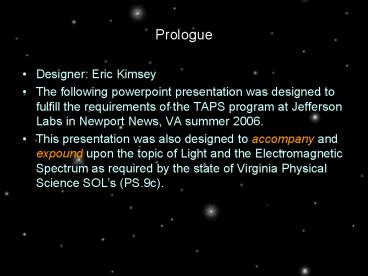Prologue - PowerPoint PPT Presentation
Title:
Prologue
Description:
Mission: to gather information on Titan (Saturn's moon) ... http://saturn.jpl.nasa.gov/spacecraft/instruments-cassini-cirs.cfm ... – PowerPoint PPT presentation
Number of Views:68
Avg rating:3.0/5.0
Title: Prologue
1
Prologue
- Designer Eric Kimsey
- The following powerpoint presentation was
designed to fulfill the requirements of the TAPS
program at Jefferson Labs in Newport News, VA
summer 2006. - This presentation was also designed to accompany
and expound upon the topic of Light and the
Electromagnetic Spectrum as required by the state
of Virginia Physical Science SOLs (PS.9c).
2
Spectroscopy
- A Tool of Astronomers
3
Definitions
- Spectroscopy- the study of the light from an
object. - Spectrometer- an instrument which spreads out
light making a spectra. - Spectra- range of electromagnetic energy
separated by wavelength.
4
Astronomers use spectroscopy because it allows
them to determine the makeup of stars without
having to be present to take samples.
5
Studying an objects spectra can tell scientists
the composition of an object, its temperature,
its density and its motion.
6
Two modern applications of spectroscopy in space
7
Mars Exploration Mission
The Mars Exploration Rovers were launched with
the goal of searching for and analyzing rock and
soils on Mars. They utilized several
spectrometers to analyze samples.
Mini-TES miniature thermal emission spectrometer
(examine rock, soil atmosphere)
MB Mossbauer Spectrometer (examine mineralogy of
rocks soils)
APXS Alpha Particle X-ray Spectrometer (analyze
elements in rocks soils)
8
Cassini-Hyugens Mission
Mission to gather information on Titan (Saturns
moon).
VIMS Visual and Infrared Mapping Spectrometer
(gather data about surface, rings atmosphere of
Titan and Saturn). CIRS Composite Infrared
Spectrometer (searches for heat and by that
gather information on the objects composition.
9
2 Basic Types of Spectra
- Continuous- energy of all wavelengths
- Discrete- energy at a particular wavelength
- Emission or bright lines
- Absorption or dark lines
10
Continuous Spectrum
- Also called thermal or blackbody spectra
- Spectra of stars, planets, moons
- Depends on temperature
- Ex sunlight passing through a prism
11
Continuous Spectrum continued
Hotter objects Shift toward this end
Longer wavelength
Shorter wavelength
Cooler objects Shift toward this end
12
Discrete Spectrum Absorption
Each element has a unique signature of absorption
lines. That pattern helps scientists identify the
element(s).
Ex stars, planets w/ atmospheres, galaxies
Spectra
Cool, thin gas
Absorption spectrum
Hot object
13
Discreet spectrum-Emission
Again, the pattern of the lines determines the
identity of the element.
Ex comets, nebula certain stars
Cold, empty space
Thin,hot gas
Emission spectrum
Spectra
14
Motion of Objects in Space
Compare the dark lines in the middle spectra to
the dark lines in the other two spectra.
Blue shift shows object is moving toward the
observer.
This shows the normal position or no motion.
This shows a red shift meaning that the object is
moving away from the observer.
15
Spectroscopy Lab
- Determining the Spectra
- of Certain Elements
16
Test your understanding...
17
What type of spectrais shown here?
- Continuous
- Absorption
- Emission
18
What type of spectrais shown here?
- Continuous
- Absorption
- Emission
19
Why does this picture represent just the
continuous spectrum of light?
20
Light is just one portion of the electromagnetic
spectrum. Name 5 other parts of the EM spectrum.
21
Acknowledgements
- www.ipac.caltech.edu/Outreach/Edu/Spectra/spec.htm
l - www.astronomynotes.com/lights4.htm
- http//saturn.jpl.nasa.gov/spacecraft/instruments-
cassini-cirs.cfm - http//pmo-sun.uoregon.edu/astrosites.html
- http//marsrovers.nasa.gov/overview
22
No way! Were you sleeping?
- Back to question 1
23
YES, we have a winner!
- To next question.
24
Pat yourself on the back!
- Next question
25
That is a definite NO!
- Back to 2nd question






























